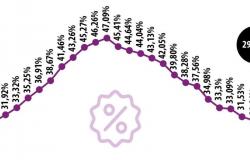The draft of the new regulation of the financial sector in the US contemplates a 50% reduction with respect to the initial capital requirements raised in the first text of the future regulations.
The Federal Reserve (Fed) has not yet published the draft of the new banking and Wall Street regulations the big banks are already celebrating their victory, even if only partial. They know that Capital requirements are going to increase, but not as much as the regulator wanted, which was around 20%.
The final percentage is not known yet.but the sector already knows that it will be far from what was initially proposed thanks to the crusade undertaken by the large banks, since the future regulations will focus mainly on them, despite the fact that they are the ones that have demonstrated the most solvency in recent months, increasing their reserves to face the impact of a potential real estate crisis.
The information, pending confirmation by the Fed, suggests that increases in the capital requirements of JPMorgan, Bank of America or Goldman Sachs They will remain in the final draft in half compared to the original proposal.
If confirmed, it would be a great victory for the sector, after insistently arguing in recent months that an increase of 20% in capital requirements would not only increase their costs and weigh down their annual accounts, but also would restrict the granting of loans.
The context has been decisive in consolidating the success of the crusade of the Wall Street titans, in an environment with interest rates at maximums in more than two decades and with the central bank delaying the de-escalation in the price of the money.
The restrictive monetary policy applied by the Fed in the last two years has not only contributed to reducing credit in the market, but has also highlighted the delicate situation of regional entities, much more exposed to the crisis in the commercial real estate sector. and they have been the big banks that have come to their rescue.
Significantly increasing its capital requirements could put the entire sector in checkespecially if interest rates do not begin to fall until after the summer, as is now feared on Wall Street – waiting for the president of the Fed, Jerome Powell, to confirm the institution’s plans this week – .
Offensive leader
The crusade against the Federal Reserve’s regulatory plan has been led by Jamie DimonCEO of JPMorgan, which a few months ago asked the rest of the sector’s executives to sit down with Powell to convey the concerns of the banking industry. Furthermore, within the institution there was a great division, with the balance tipping with each small bank failure towards more lax regulation that would give some air to the balance sheets.
“What person, in what ivory tower, thinks that’s a rational thing to do?“. Dimon has had no qualms about sharing his reflections publicly, calling the Fed’s original proposal “defective and poorly calibrated». Furthermore, the manager took advantage of the annual letter he addresses to the bank’s shareholders to make it clear that the regulator was increasingly further from reality, ensuring that the relations between supervisor and supervised “have deteriorated and are increasingly less constructive.”
Now, the regulations not only depend on the Fed, but two other regulators are also involved in their final draft: the Deposit Insurance Fund (FDIC) and the Office of Currency Supervision (OCC). ). Although there is no scheduled date, the sector hopes that the final draft will be published at the end of this yearalthough it could be approved sooner.
The first draft was made public in July of last yearprovoking an angry reaction from the large Wall Street banks, which complained not only about the comparative insult, but also about the strong impact that the measure would have on their businesses and on the functioning of the financial sector throughout the country.
Also in the US Congress, a group of legislators has come out in defense of the big banks. The war against regulations even snuck into some very expensive television advertisements during National Football League games so that it would be clear to the taxpayer, and voter this year in the presidential elections, whose fault it was if the mortgages for Buying a house continues to climb freely next year, although rates will begin to fall by then.
Powell himself has appeared several times in recent months to explain that it is only a draft and that the final idea is to lower the initial claims and not add new burdens to the sector. Now, it seems that these words are concretized in ua 50% reduction on the first approach.





